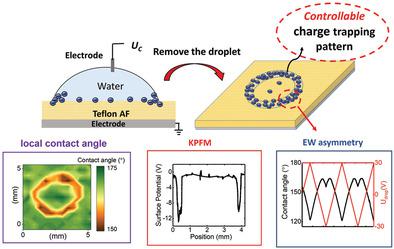Our official English website, www.x-mol.net, welcomes your feedback! (Note: you will need to create a separate account there.)
Electrically Controlled Localized Charge Trapping at Amorphous Fluoropolymer-Electrolyte Interfaces.
Small ( IF 13.3 ) Pub Date : 2019-12-11 , DOI: 10.1002/smll.201905726 Hao Wu 1, 2, 3 , Ranabir Dey 3, 4 , Igor Siretanu 3 , Dirk van den Ende 3 , Lingling Shui 1, 2 , Guofu Zhou 1, 2, 5 , Frieder Mugele 3
Small ( IF 13.3 ) Pub Date : 2019-12-11 , DOI: 10.1002/smll.201905726 Hao Wu 1, 2, 3 , Ranabir Dey 3, 4 , Igor Siretanu 3 , Dirk van den Ende 3 , Lingling Shui 1, 2 , Guofu Zhou 1, 2, 5 , Frieder Mugele 3
Affiliation

|
Charge trapping is a long-standing problem in electrowetting on dielectric, causing reliability reduction and restricting its practical applications. Although this phenomenon is investigated macroscopically, the microscopic investigations are still lacking. In this work, the trapped charges are proven to be localized at the three-phase contact line (TPCL) region by using three detecting methods-local contact angle measurements, electrowetting (EW) probe, and Kelvin probe force microscopy. Moreover, it is demonstrated that this EW-assisted charge injection (EWCI) process can be utilized as a simple and low-cost method to deposit charges on fluoropolymer surfaces. Charge densities near the TPCL up to 0.46 mC m-2 and line widths of the deposited charge ranging from 20 to 300 µm are achieved by the proposed EWCI method. Particularly, negative charge densities do not degrade even after a "harsh" testing with a water droplet on top of the sample surfaces for 12 h, as well as after being treated by water vapor for 3 h. These findings provide an approach for applications which desire stable and controllable surface charges.
中文翻译:

非晶态含氟聚合物-电解质界面上的电控局域电荷陷阱。
电荷俘获是电介质上电润湿的一个长期存在的问题,导致可靠性降低并限制了其实际应用。尽管从宏观上研究了这种现象,但仍缺乏微观研究。在这项工作中,通过使用三种检测方法-局部接触角测量,电润湿(EW)探针和开尔文探针力显微镜,证明了捕获的电荷位于三相接触线(TPCL)区域。此外,已证明该EW辅助电荷注入(EWCI)工艺可作为一种简单且低成本的方法将电荷沉积在含氟聚合物表面上。拟议的EWCI方法可在TPCL附近获得高达0.46 mC m-2的电荷密度,沉积电荷的线宽范围为20至300 µm。特别,负电荷密度即使在样品表面顶部的水滴进行“苛刻”测试12小时后以及经过水蒸气处理3小时后也不会降低。这些发现为需要稳定和可控表面电荷的应用提供了一种方法。
更新日期:2020-01-16
中文翻译:

非晶态含氟聚合物-电解质界面上的电控局域电荷陷阱。
电荷俘获是电介质上电润湿的一个长期存在的问题,导致可靠性降低并限制了其实际应用。尽管从宏观上研究了这种现象,但仍缺乏微观研究。在这项工作中,通过使用三种检测方法-局部接触角测量,电润湿(EW)探针和开尔文探针力显微镜,证明了捕获的电荷位于三相接触线(TPCL)区域。此外,已证明该EW辅助电荷注入(EWCI)工艺可作为一种简单且低成本的方法将电荷沉积在含氟聚合物表面上。拟议的EWCI方法可在TPCL附近获得高达0.46 mC m-2的电荷密度,沉积电荷的线宽范围为20至300 µm。特别,负电荷密度即使在样品表面顶部的水滴进行“苛刻”测试12小时后以及经过水蒸气处理3小时后也不会降低。这些发现为需要稳定和可控表面电荷的应用提供了一种方法。


























 京公网安备 11010802027423号
京公网安备 11010802027423号